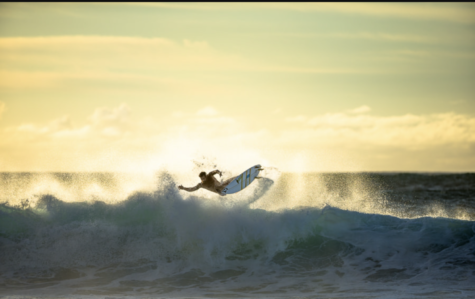Although it is commonly thought that surfing is a summer activity, many surfers indulge in winter surfing. They can be seen riding waves along the West Coast, East Coast, and even in the Great Lakes during the winter months. For many, the sport has no specific season. Surfing the Great Lakes might sound absurd, but it’s actually more common than expected. The increased winds and frequent swells that winter brings provides the biggest and best waves. Ben Gravy, influencer and surfer, said, “From the frozen beaches of Lake Michigan to the big open faces of Lake Erie, the classic local surfers on Lake Superior to the big surf on Lake Ontario, this is what it’s all about!” Although a unique and fascinating experience, winter surfing can be very grueling due to the bitter cold winds, freezing temperatures, and icy water. On the other hand, the unique experience of surfing the Great Lakes has been described as, “A wave I’ll never forget,” by surf shop owner Ryan Gerard.
While surfing one of the Great Lakes might be unique, they’re not very accessible to those living closer to the coast. Nonetheless, surfing coastal beaches like those on the Jersey Shore is still loads of fun. The average wave height during the winter is around 4.5 feet which trumps the summer waves that average 3 feet. This increase in wave size makes for more thrilling, but also more challenging surf. Coupled with the unpredictability of the ocean, and the powerful sets that can roll in, the winter months are not very friendly for beginners. However, for people like Rob Kelly, member of the Numbskulls blog, winter is the perfect time to surf. “Winter’s coming, bigger swells, no crowds. It’s all just bittersweet.” Nevertheless, people like Rob Kelly must either be thick-skulled or have thick wetsuits to endure the winter sport.
An appropriate wetsuit is essential if someone wishes to survive the bitter cold water, or at least feel comfortable. It’s recommended that a surfer wears at least a 5/4 mm wetsuit when surfing water below 52 degrees. 5/4 refers to the thickness of the wetsuit’s torso and limbs, 5 mm being the torso and 4 mm being the limbs. Without properly protecting the torso while surfing in freezing temperatures, people are at the risk of hypothermia. Because the average water temperature in New Jersey is 44 degrees during December, a 5/4 mm wetsuit seems appropriate. Along with a thick wetsuit, surfers should wear boots, gloves, and a hood.
Chances are that the majority will not be found surfing this winter. However, as someone who has surfed during the winter before and did not catch a single wave, some experience would definitely come in handy. So, over the summer try surfing so that one day you can experience the thrill of doing it in the winter.








